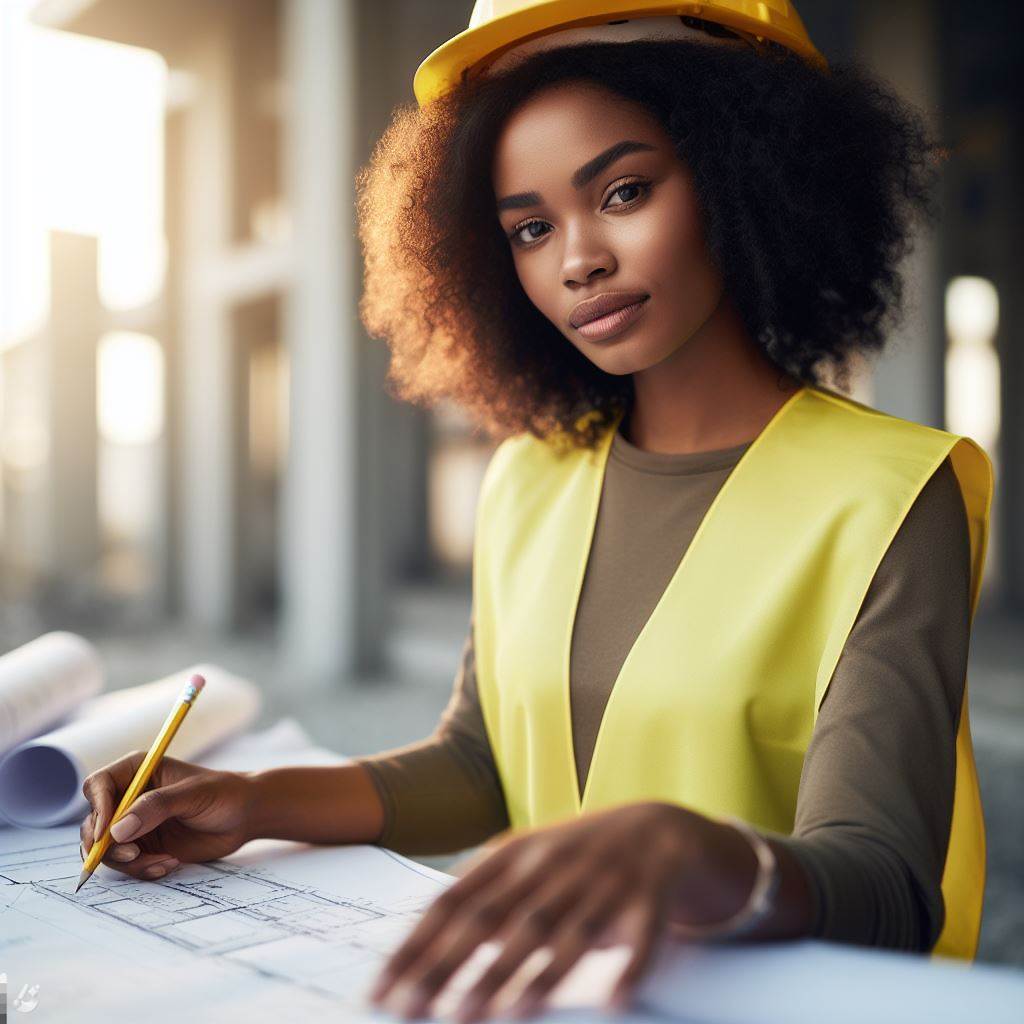Introduction
The future of architecture in the UK is a topic of great importance.
Architecture plays a significant role in shaping the built environment, and its impact cannot be underestimated.
The UK has a rich architectural history that has greatly influenced the profession.
From iconic landmarks like the Tower of London and Buckingham Palace to modern structures like the Gherkin and the Shard, the UK is home to architectural marvels that showcase the country’s design prowess.
Architects in the UK have long been at the forefront of innovative and cutting-edge designs, pushing the boundaries of what is possible in the built environment.
The future of architecture in the UK holds immense potential.
As technology advances and new materials and techniques become available, architects will have the opportunity to create structures that are not only aesthetically pleasing but also sustainable and environmentally friendly.
The challenges posed by climate change and urbanization make it crucial for architects to consider the impact of their designs on the surrounding environment.
Furthermore, architecture has a significant impact on the economy.
The construction industry contributes billions to the UK’s GDP, and the success of architectural projects can attract investment and tourism, boosting local economies.
In fact, the future of architecture in the UK is a topic that deserves attention.
With its rich history and influential architectural achievements, the UK is well-positioned to continue leading the way in the profession.
By embracing innovation and sustainability, architects can shape a built environment that not only meets the needs of the present but also prepares for the challenges of the future.
Current State of Architecture in the UK
In the architecture industry, the UK is witnessing various trends and practices that are shaping its future.
- Architects in the UK prioritize sustainable designs, aiming to reduce energy usage and use eco-friendly materials.
- Repurposing historic buildings showcases innovative approaches, preserving heritage with a modern touch.
- Urban revitalization focuses on architects creating mixed-use spaces for vibrant, sustainable communities.
- Advanced technology like 3D modeling aids architects in precise design visualization and client communication.
- Recognizable landmarks such as the London Eye and the Shard symbolize architectural excellence in the UK.
- Sustainable marvels like the Eden Project and the Bullitt Center highlight eco-conscious architectural achievements.
- Modern buildings emphasize sustainability with features like ample natural light and renewable energy systems.
- Collaboration among architects, engineers, and planners ensures holistic, well-informed project designs.
- Art integration enriches UK architecture, adding vibrancy with stunning artworks and sculptures.
- Architects contribute to enhancing community life by designing engaging public spaces like parks and plazas.
The current state of architecture in the UK showcases a blend of innovation, sustainability, and creativity.
Architects are pushing boundaries to create visually striking yet environmentally conscious structures that contribute to the overall development of the country.
The integration of technology and sustainable practices has opened new avenues for future architectural endeavors in the UK.
Read: UK Architects: Education Path & Qualifications
Challenges Faced by Architects in the UK
In the ever-evolving field of architecture, professionals in the UK face numerous challenges that impact their work and the industry as a whole.
From economic fluctuations to the issue of affordable housing, let’s delve into some of the key challenges architects encounter in the UK.
1. Economic Fluctuations
- Economic ups and downs pose a significant challenge for architects in the UK.
- During economic downturns, construction projects often decline, leading to reduced opportunities for architects.
- Architects must adapt their business models to withstand economic volatility.
- Efficiency and cost-effectiveness become crucial considerations when planning projects during uncertain times.
- Collaboration with other professionals, such as engineers and contractors, becomes essential to overcome financial challenges.
2. Affordable Housing Crisis
- The issue of affordable housing is a pressing concern for architects and society at large in the UK.
- Increasing population and urbanization intensifies the demand for affordable housing solutions.
- The lack of affordable homes creates socio-economic disparities and affects the overall quality of life.
- Architects face the challenge of designing affordable housing that meets high-quality standards.
- Balancing cost considerations with innovative design principles becomes crucial for architects working on affordable housing projects.
3. Changing Architectural Design
- Affordable housing concerns and evolving societal needs influence architectural design in the UK.
- Architects must find innovative approaches to maximize space and create sustainable, yet affordable, housing solutions.
- Designing for energy efficiency and integrating renewable technologies is essential for future-proofing buildings.
- The shift towards sustainable architecture requires architects to consider environmental impacts throughout the design process.
- Adapting to changing regulations and incorporating new materials and construction techniques further complicates the architectural design process.
4. Technological Advancements
- Rapid technological advancements pose challenges and opportunities for architects in the UK.
- The integration of Building Information Modelling (BIM) and other digital tools transforms the design and construction process.
- Architects must adapt to new software, keep up with technological trends, and acquire relevant skills.
- The use of virtual reality and augmented reality in architecture enhances visualization and improves client engagement.
- However, staying up to date with technological advancements can be challenging, especially for smaller architectural firms.
5. Skill Shortages
- The architectural industry in the UK faces a shortage of skilled professionals.
- Retirement, lack of interest among young individuals, and a limited pool of experienced architects contribute to the skill shortage.
- Efforts to attract and retain talented architects become imperative to overcome this challenge.
- Investing in education and training programs can help bridge the skill gap and ensure a thriving future for the profession.
- Collaboration with educational institutions and promoting architectural careers to young people is vital in addressing the shortage.
In short, architects in the UK encounter various challenges that shape the future of their profession.
Economic fluctuations, affordable housing concerns, evolving design requirements, technological advancements, and skill shortages significantly impact the industry.
Overcoming these challenges necessitates adaptability, innovation, collaboration, and a commitment to designing sustainable and affordable solutions that meet the changing needs of society.
Read: Top UK Architecture Schools: A Detailed Guide

Emerging Technologies and Innovations
Technological advancements are revolutionizing the architecture industry, impacting every aspect of design and construction.
Two key technologies, artificial intelligence (AI) and 3D printing, are spearheading this transformation.
The Impact of Emerging Technologies
- AI enables architects to analyze massive amounts of data and generate design proposals based on complex parameters.
- 3D printing has the potential to revolutionize construction by allowing architects to create intricate building components.
- Through these technologies, architects can now push the boundaries of design and construction with ease and efficiency.
Changing the Way Architects Design and Construct Buildings
- Design processes are becoming more iterative and interactive, thanks to AI’s ability to generate and analyze design variations.
- Architects can now experiment with multiple design options rapidly, allowing for enhanced creativity and innovation.
- Moreover, 3D printing enables architects to construct complex geometries and intricate structures with precision.
- Traditional construction methods are being challenged as 3D printing allows for faster and more cost-effective construction.
- These technologies have the potential to transform how architects approach sustainability and energy efficiency in design.
Potential Benefits and Challenges
- One major benefit of incorporating emerging technologies is the potential for cost reduction throughout the design and construction phases.
- AI, for example, enables architects to optimize building performance and minimize energy consumption.
- Furthermore, 3D printing reduces material waste, as it allows for the precise fabrication of building components.
- However, the adoption of these technologies also poses challenges, such as the need for architects to upskill and adapt to new tools and methodologies.
- Moreover, concerns about the impact of AI on job loss within the industry have been raised.
- Additionally, the reliance on emerging technologies raises questions about privacy, security, and ethical issues.
Overall, emerging technologies like AI and 3D printing are reshaping the architecture industry, leading to more innovative and sustainable designs.
While they offer significant benefits, integrating these technologies into practice requires careful consideration of potential challenges.
Architects must embrace these innovations and continuously adapt to leverage their full potential.
Read: Day in the Life of a UK CAD Technician
See Related Content: Emerging Materials in UK Civil Engineering
Personalized UK Career Consulting
Receive tailored career guidance designed just for you. Get actionable steps and expert support to boost your career in 1-3 days. Take control of your career now.
Get StartedSustainable Design and Green Architecture
The field of architecture is witnessing an increasing importance placed on sustainable design.
This shift in focus is driven by the need to create buildings that are environmentally friendly and energy-efficient.
There is a growing demand for green buildings and eco-friendly practices.
People are becoming more conscious of the impact their actions have on the planet and are actively seeking out sustainable solutions.
To meet this demand, architects are adopting innovative design strategies that prioritize energy efficiency, waste reduction, and the use of renewable materials.
- Architects integrate renewable energy sources like solar panels and wind turbines to reduce fossil fuel dependency.
- Passive design optimizes orientation, lighting, and ventilation, creating energy-efficient, healthier buildings.
- Recycled materials like reclaimed wood decrease resource demand and waste in green architecture.
- Water conservation strategies include fixtures and recycling systems to reduce consumption.
- Green roofs and vertical gardens improve air quality and biodiversity while enhancing aesthetics.
In the UK:
- BREEAM assesses buildings for sustainability, focusing on energy, water, and ecological impact.
- The Code for Sustainable Homes mandates energy efficiency and waste management in residences.
- The government aims for net-zero greenhouse gas emissions by 2050, encouraging sustainable design.
- Local authorities include sustainable design policies to promote eco-friendly practices in planning.
- The UK Green Building Council offers resources to support sustainable building development.
Generally, sustainable design and green architecture are now at the forefront of the architectural industry in the UK.
The increasing importance placed on environmental responsibility has led to a growing demand for eco-friendly buildings and practices.
With the support of initiatives and regulations, architects are adopting innovative strategies to create sustainable and energy-efficient designs.
The future of architecture in the UK is undoubtedly green.
Read: CAD Technician Career Path in the UK
Gain More Insights: The Future of Mech Engineering in the UK
The Changing Role of Architects
Architecture is an ever-evolving field, and architects are constantly adapting to societal and technological changes.
1. Evolution of Architects’ Role
Architects have transitioned from designing static structures to creating dynamic, interactive spaces.
They now consider factors like sustainability, energy efficiency, and user experience in their designs.
Furthermore, architects incorporate technological advancements like Building Information Modeling (BIM) and 3D printing.
These tools allow architects to visualize and construct complex designs, revolutionizing the architectural process.
2. Emergence of Interdisciplinary Approaches
Architecture has witnessed the rise of interdisciplinary approaches, embracing collaboration with other fields.
Architects now work closely with engineers, urban planners, and environmental consultants.
Your Dream Job Starts with a Perfect CV
Get a tailored CV and cover letter that captures your unique strengths and stands out in your industry. Let us help you make an unforgettable first impression.
Get StartedThis interdisciplinary approach ensures well-rounded and functional designs that meet the needs of the community.
Moreover, architects collaborate with artists, sociologists, and psychologists to understand human behavior and create spaces that enhance well-being.
3. Importance of Collaboration and Community Engagement
In the future of architecture, collaboration and community engagement play a vital role.
Architects actively involve the community in the design process to create meaningful and inclusive spaces.
By seeking feedback and incorporating local knowledge, architects can design buildings that reflect the community’s unique character.
This participatory approach fosters a sense of ownership and pride among the residents.
Furthermore, architects collaborate with contractors and suppliers to ensure the successful execution of their designs.
4. Shifting Focus towards Sustainable Design
In response to environmental concerns, architects are increasingly prioritizing sustainable design practices.
They integrate renewable energy sources and employ eco-friendly materials in their projects.
Architects design buildings that maximize energy efficiency, reduce waste, and minimize their carbon footprint.
Additionally, they create spaces that promote natural ventilation, daylight, and green areas for improved well-being.
5. Incorporating Smart Technologies
Technology has greatly influenced the role of architects, especially with the emergence of smart cities.
Architects now incorporate Internet of Things (IoT) devices and sensors in their designs to optimize energy consumption.
Smart buildings can adjust lighting, heating, and air conditioning based on occupancy, reducing energy wastage.
Optimize Your LinkedIn for Success
Boost your LinkedIn profile with a professional bio, keyword-rich headline, and strategic recommendations that attract recruiters. Stand out from the crowd and get noticed.
Optimize NowFurthermore, architects integrate smart design elements, such as automated shading systems and energy monitoring tools.
6. Addressing Social and Cultural Needs
Architects are increasingly focusing on creating spaces that address the social and cultural needs of communities.
They design buildings that promote inclusivity, accessibility, and social interaction.
Architects consider the diverse identities, traditions, and histories of a place when conceptualizing their designs.
By embracing cultural nuances, architects create spaces that celebrate diversity and enhance the urban fabric.
Therefore, architects are adapting to societal and technological changes by embracing interdisciplinary approaches, collaboration, sustainability, and smart design.
They are at the forefront of shaping the built environment, ensuring that it reflects the needs and aspirations of communities.
Conclusion
This blog post explored the future of architecture in the UK and highlighted several key points.
We discussed how advancements in technology and sustainability are shaping the industry.
The importance of designing inclusive and adaptable spaces was also emphasized.
Looking ahead, architects in the UK face both opportunities and challenges.
The potential to create innovative and environmentally friendly structures is vast.
However, they must also navigate changing regulations and societal demands for more inclusive and sustainable designs.
Despite these challenges, the future of architecture in the UK looks promising.
Architects have the ability to influence and shape the built environment for the better.
With a focus on collaboration and embracing new technologies, they can create spaces that are both aesthetically pleasing and socially responsible.
All in all, the future of architecture in the UK holds great potential for architects who are willing to adapt, innovate, and create sustainable and inclusive designs.
By embracing these opportunities, architects can play a crucial role in shaping a brighter and more sustainable future.
[E-Book for Sale]
500 Cutting-Edge Tech Startup Ideas for 2024 & 2025: Innovate, Create, Dominate
$19.99 • 500 Tech Startup Ideas • 62 pages
You will get inspired with 500 innovative tech startup ideas for 2024 and 2025, complete with concise descriptions to help you kickstart your entrepreneurial journey in AI, Blockchain, IoT, Fintech, and AR/VR.




